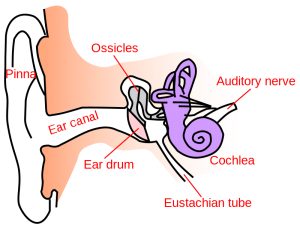Types of Hearing Loss
Red Flags: Signs of Hearing Loss
The only way to determine the presence or extent of hearing loss is to have a hearing test administered by an audiologist. Signs of hearing loss that might indicate a hearing evaluation is recommended include:
The individual experiencing hearing loss frequently is not aware of their own hearing deficits. Other people’s family members, coworkers, or friends are often the first to appreciate one’s hearing loss. Ironically, the individual with hearing loss is frequently the last person to realize and appreciate their own hearing loss.
Schedule an Appointment Today
How do we hear?
We hear by having sound waves funneled into the ear canal. The pinna, the external appendage which leads to the ear canal, serves to funnel sound into the ear canal. The sound waves then make the tympanic membrane (ear drum) vibrate. The vibrations are transmitted through the middle ear through three small middle ear auditory bones called ossicles: the malleus, incus and stapes. Each of these small bones are connected to each other and facilitate transmission of sound vibrations. The third bone, the stapes, vibrates in an oval window which connects to the hearing organ, the cochlea. These sound vibrations are then converted into an electrical impulse in the cochlea. Once converted into a nerve impulse, the signal travels to the brain. All of these functions occur in a very quick and seamless manner.

Middle ear: ear drum and 3 auditory bones (ossicles)
Inner ear: cochlea- hearing organ and semicircular canals-balance organ
Types of hearing loss

Sensorineural hearing loss (SNHL)
Sensorineural hearing loss (SNHL) occurs due to problems involving the cochlea of the inner ear. This type of hearing loss can be caused by a number of factors including aging, genetics, illness, injury, noise exposure and medications. It typically cannot be reversed by medical or surgical intervention.
The most common form of SNHL is presbycusis, (prez-bi-kyoo-sis) age-related hearing loss. Most commonly, presbycusis arises from changes in the inner ear as a result of the aging process. Genetics can play a significant role in determining if one is at risk of developing presbycusis at an early age. Another common form of SNHL is from excessive noise exposure. This form of hearing loss cannot be reversed, but can be improved upon with hearing aids.

Conductive hearing loss (CHL)
Conductive hearing loss (CHL) occurs due to problems involving the outer and middle ear. In this form of hearing loss, the sound waves do not conduct adequately through the outer and middle ear mechanism. A conductive hearing loss is theoretically reversible with medical or surgical intervention. Examples of problems causing conductive hearing losses include: wax impaction of the outer ear. A hole in the tympanic membrane or ear drum. Fluid or infection of the middle ear, common with childhood ear infections. A problem with the auditory bones preventing the proper conduction of sound to the cochlea. Each of these problems prevents the normal transmission and conduction of sound to the cochlea.

Selected in Washingtonian Top Doctors Since 1998
Dr. Winkler is an extremely talented and dedicated physician who listens carefully and considers the whole health history as he develops a treatment plan…He’s appropriately cautious and will demur on a procedure if there’s a safer alternative. However, if a procedure is warranted, he has the talent to do it well.
Everything about this office is excellent; Dr. Winkler is superb. Most thorough history and exam; patient and thorough explanations of everything; …produced great improvement in a problem that had festered for months…Could not be better!!
My child’s pediatrician recommended Dr. Winkler as her first choice to perform a tonsillectomy…Dr. Winkler was matter-of-fact, friendly, unhurried, professional, and has a wicked sense of humor…His follow-up care was thorough, kind, accurate, and timely. He’s a top notch doctor!
Our niece had a tough recovery from surgery due to her already being sick …. Dr. Winkler was amazing. Called us every single day for two weeks. Saw us as necessary. I will use him again in a heartbeat.
My husband has been fighting a rare and deadly cancer that was found in his nose by Dr. Hao for over six years now. We both truly believe that if not for the professionalism and concern that has shown us over those years, that my husband would not be alive today. We cannot praise Dr. Hao enough.
I met with Dr. Capobianco a few months ago and she was fantastic…It has been a game changer in terms of life style…Dr. Capobianco was extremely professional, helpful and a joy to work with. I would recommend her and the staff at the office without hesitation. They are always helpful and friendly.





